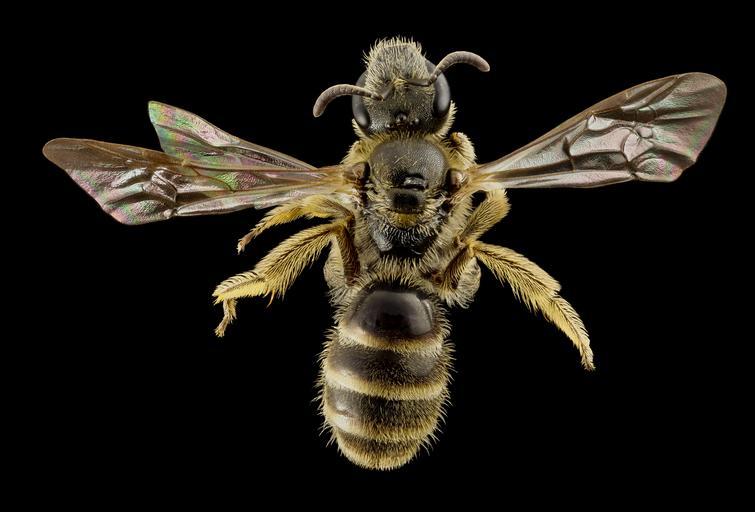MAKE A MEME
View Large Image

| View Original: | Lasioglossum_albipes,_f,_france,_back_2014-11-02-00.06.29_ZS_PMax.jpg (5351x3629) | |||
| Download: | Original | Medium | Small | Thumb |
| Courtesy of: | www.flickr.com | More Like This | ||
| Keywords: halictidae taxonomy:binomial=lasioglossum albipes taxonomy:binomial=lasioglossumalbipes lasioglossum albipes lasioglossumalbipes lasioglossum france europe hairy tongue hairytongue apidae apoidea hymenoptera social insect socialinsect insect insecta colonial polysocial droege biml usgsbiml usgs stackshot zerene stacker zerenestacker native bee nativebee black background animal bee Lasioglossum albipes, Polysocial Hairy-tongued Bee, specimen collected in France Because of the very well known biology of Honey Bees some may believe that all bees have complex social lives. However, very few of the more than 20,000 species of bees discovered actually has a complex social life. Indeed, most bees are solitary and even most social bees live in colonies of no more than 10 individuals. The Polysocial Hairy-tongue varies in its preferences: in some parts of its range it is social, with small colonies, while in others it is entirely solitary. But why? Generally, social bees produce two or more broods per year – minimally, the queen will produce a brood of workers and then the workers forage and construct pollen balls for the queen to lay eggs upon. If there are only two broods per year, the second one will be of males and the next year’s queens. This works well in parts of the world where the summers are reasonably long. However, in cold mountaintops, or unpredictable but cold far northern environments, the summer is too short for there to be time to produce two broods and some bees have managed to revert to a solitary lifestyle to persist in these colder areas. The Polysocial Hairy-tongue is one such species. Even within the country of France, this bee will be social in lowland areas with quite long summers, but they are solitary in mountainous regions. ~~~~~~~~~~{{{{{{0}}}}}}~~~~~~~~~~ All photographs are public domain, feel free to download and use as you wish. Photography Information: Canon Mark II 5D, Zerene Stacker, Stackshot Sled, 65mm Canon MP-E 1-5X macro lens, Twin Macro Flash in Styrofoam Cooler, F5.0, ISO 100, Shutter Speed 200 Further in Summer than the Birds Pathetic from the Grass A minor Nation celebrates Its unobtrusive Mass. No Ordinance be seen So gradual the Grace A pensive Custom it becomes Enlarging Loneliness. Antiquest felt at Noon When August burning low Arise this spectral Canticle Repose to typify Remit as yet no Grace No Furrow on the Glow Yet a Druidic Difference Enhances Nature now -- Emily Dickinson Want some Useful Links to the Techniques We Use? Well now here you go Citizen: Basic USGSBIML set up: www.youtube.com/watch?v=S-_yvIsucOY USGSBIML Photoshopping Technique: Note that we now have added using the burn tool at 50% opacity set to shadows to clean up the halos that bleed into the black background from "hot" color sections of the picture. www.youtube.com/watch?v=Bdmx_8zqvN4 PDF of Basic USGSBIML Photography Set Up: ftp://ftpext.usgs.gov/pub/er/md/laurel/Droege/How%20to%20Take%20MacroPhotographs%20of%20Insects%20BIML%20Lab2.pdf Google Hangout Demonstration of Techniques: plus.google.com/events/c5569losvskrv2nu606ltof8odo or www.youtube.com/watch?v=4c15neFttoU Excellent Technical Form on Stacking: www.photomacrography.net/ Contact information: Sam Droege [email protected] 301 497 5840 Lasioglossum albipes, Polysocial Hairy-tongued Bee, specimen collected in France Because of the very well known biology of Honey Bees some may believe that all bees have complex social lives. However, very few of the more than 20,000 species of bees discovered actually has a complex social life. Indeed, most bees are solitary and even most social bees live in colonies of no more than 10 individuals. The Polysocial Hairy-tongue varies in its preferences: in some parts of its range it is social, with small colonies, while in others it is entirely solitary. But why? Generally, social bees produce two or more broods per year – minimally, the queen will produce a brood of workers and then the workers forage and construct pollen balls for the queen to lay eggs upon. If there are only two broods per year, the second one will be of males and the next year’s queens. This works well in parts of the world where the summers are reasonably long. However, in cold mountaintops, or unpredictable but cold far northern environments, the summer is too short for there to be time to produce two broods and some bees have managed to revert to a solitary lifestyle to persist in these colder areas. The Polysocial Hairy-tongue is one such species. Even within the country of France, this bee will be social in lowland areas with quite long summers, but they are solitary in mountainous regions. ~~~~~~~~~~{{{{{{0}}}}}}~~~~~~~~~~ All photographs are public domain, feel free to download and use as you wish. Photography Information: Canon Mark II 5D, Zerene Stacker, Stackshot Sled, 65mm Canon MP-E 1-5X macro lens, Twin Macro Flash in Styrofoam Cooler, F5.0, ISO 100, Shutter Speed 200 Further in Summer than the Birds Pathetic from the Grass A minor Nation celebrates Its unobtrusive Mass. No Ordinance be seen So gradual the Grace A pensive Custom it becomes Enlarging Loneliness. Antiquest felt at Noon When August burning low Arise this spectral Canticle Repose to typify Remit as yet no Grace No Furrow on the Glow Yet a Druidic Difference Enhances Nature now -- Emily Dickinson Want some Useful Links to the Techniques We Use? Well now here you go Citizen: Basic USGSBIML set up: www.youtube.com/watch?v=S-_yvIsucOY USGSBIML Photoshopping Technique: Note that we now have added using the burn tool at 50% opacity set to shadows to clean up the halos that bleed into the black background from "hot" color sections of the picture. www.youtube.com/watch?v=Bdmx_8zqvN4 PDF of Basic USGSBIML Photography Set Up: ftp://ftpext.usgs.gov/pub/er/md/laurel/Droege/How%20to%20Take%20MacroPhotographs%20of%20Insects%20BIML%20Lab2.pdf Google Hangout Demonstration of Techniques: plus.google.com/events/c5569losvskrv2nu606ltof8odo or www.youtube.com/watch?v=4c15neFttoU Excellent Technical Form on Stacking: www.photomacrography.net/ Contact information: Sam Droege [email protected] 301 497 5840 | ||||